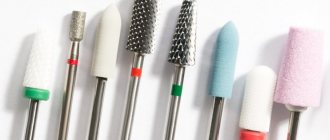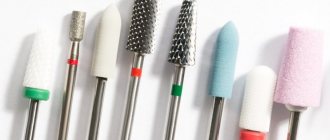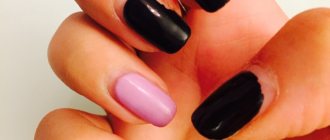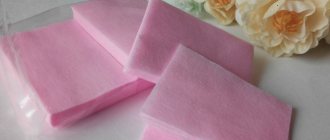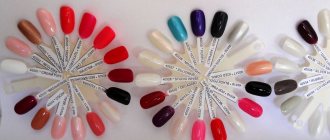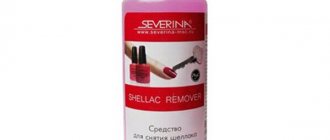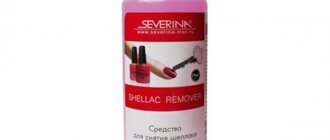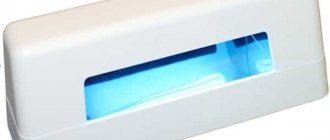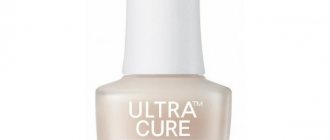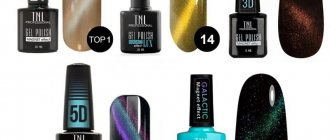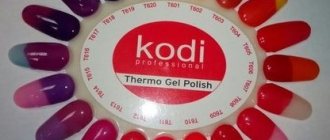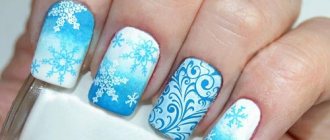The cutter for removing gel polish can be spherical, cone-shaped, metal, ceramic and other types. Each of them has an individual purpose, but they are all needed to perform a high-quality manicure.
The technique of removing decorative coating involves making light, stroking movements from the cuticle to the end of the nail. The middle of the nail is treated with wide nozzles, the sides of the plate with narrow ones. Silicone tips are used only for polishing the surface of the nail (base layer) before applying a new layer of gel polish or shellac.
The cost of cutters is variable, ranging from 150-450 rubles and depends on the materials, shapes, sizes and reputation of the manufacturer.
What is a cutter for removing gel polish?
A cutter for removing gel polish is a rotating tool that is equipped with a sharp tip. It works in a machine that is designed to perform standard hardware manicure. The cutter changes depending on the tasks assigned (it is available with different notches and degrees of abrasiveness), and rotates at high speed.
If an experienced professional uses the machine, then it takes a minimum of time to remove gel polish with a cutter - no more than 15 minutes for both hands. The procedure cannot be carried out in this way if:
- severe dystrophy and excessive sensitivity of the nail plates;
- existing allergy to dust in the master or female client.
Another disadvantage of using a cutter to remove gel polish is the high cost of the machine for hardware manicure and the actual rotating attachments, and using cheap equipment for this manipulation is strictly not recommended.
Cutters for manicure. What do the colored notches mean?
× Our best online master classes are available to you.
Colored notches on cutters indicate the degree of rigidity of the cutter and its abrasiveness. For hardware manicure, cutters with different abrasiveness are used.
When and what kind of cutter should you use for hardware manicure? The answers are in the video from Anastasia Luksha.
A video fragment of Anastasia Luksha’s online course “Hardware Manicure” about the color classification of cutters in hardware manicure.
What does this or that color of the notch on a cutter tell us, and which cutters are most often used in hardware manicure.
Black The roughest cutter. “Black” cutters are not used when working with natural nails and especially skin. We use it only for working with artificial nails. Green Diamond cutters with green notches are also not often used for manicure. As a rule - for working with rough skin. A ceramic cutter with a green notch is used to remove gel polish. Blue The most commonly used “color” in manicure, especially when it comes to diamond cutters. Used for working on leather. Red Quite soft cutter. Used for treating skin and nails. If “blue” cutters are used to work with skin, then red ones can, in some cases, be used on the nail plate. Yellow
A soft cutter that can be used on both skin and natural nails.
masterakrasoti.ru
What are the advantages of removing gel polish with a machine?
The advantages of removing gel polish with a device include:
- maintaining the density and structure of the nail plate - gel polish removers dry out the nails greatly, which leads to their rapid delamination;
- no contact of the cutter with the surface of the nail, so damage is excluded;
- complete preservation of the base layer of the coating, which prevents the negative impact of external factors on the nail.
The main advantage of the method is the refusal to use removers, which aggressively affect not only the gel polish, but also directly on the natural nail plate. Experts say that thinning, separation and brittleness of nails after a manicure with gel polish do not appear after the use of such specific materials for decorative coating, but against the background of the use of liquids to remove it.
User voting
What manicure cutters from Aliexpress would you choose or recommend?
Feecy 6T
0.00% ( 0 )
Asweina
50.00% ( 1 )
ERUIKA
0.00% ( 0 )
Santilady
0.00% ( 0 )
Missguoguo
0.00% ( 0 )
Feecy S06
50.00% ( 1 )
LCJ 2018-020-DMT
0.00% ( 0 )
RIKONKA
0.00% ( 0 )
TP-C1903D
0.00% ( 0 )
Proberra
0.00% ( 0 )
TP-S3
0.00% ( 0 )
YZ0054
0.00% ( 0 )
What types of machines are there for removing gel polish and shellac?
Depending on the purpose for which the machine for removing gel polish and shellac will be used, you can purchase home or professional equipment. The first option has the following characteristics:
- compact dimensions;
- low power;
- minimum set of cutters (no more than 10 pieces);
- The quality of the attachments is average.
It will be problematic to quickly and efficiently remove gel polish or shellac with home machines, because their cutters wear out a lot.
Professional gel polish remover machines have:
- high power;
- automatic tip ventilation;
- reverse and direct rotation of cutters;
- a large set of attachments (more than 10 pieces);
- the ability to work in different modes and independently adjust the speed of rotation of the nozzle.
It is professional equipment that allows you to work in “emergency” mode and cope with any type of decorative coating.
Watch this video about which manicure machine to choose:
Are there any for left-handed people?
For left-handers, manufacturers introduce special cone-shaped or cylindrical cutters, which are distinguished by a cross cut. Carbide cutters are optimal for left-handers - they are universal and work equally effectively in both forward and reverse rotation.
If it is necessary to treat areas of the lateral skin folds and cuticles, left-handed people will benefit from streamlined ceramic attachments.
Shapes of cutters (for correcting the length and shape of the nail)
To adjust the length of the overgrown part of the nail, cylinder attachments are often used. The specific purpose depends on the characteristics of the nozzle. Thick “drums” with a highly abrasive surface quickly and efficiently remove the length of dense, rough nails on the fingers and toes. Rough cylinders are convenient for shaping the plate into an oval, rectangular shape, and for correction on artificial surfaces. Low- and medium-abrasive cylinders with a rounded top are used for finishing the cut of a natural nail. The length and shape of the regrown part of the plate is also changed using:
- spherical, disk attachments - they are used mainly for correction of a natural plate;
- cones - they remove unevenness, polish cuts, and reduce the length of natural nails;
- needle-shaped cutters - if you need to file a nail in a hard-to-reach or sensitive place.
Which cutter to remove gel polish with, their main types
You can remove gel polish with different cutters; masters distinguish three main types of them, which differ in shape:
- Globular . Used for processing cuticles, the diameter ranges from 1-2-3 mm. A spherical cutter ideally processes the cuticle and the nail near it; it can also be used to level the surface of the plate and get rid of tubercles and roughness. Disadvantages of this type of attachment: it cannot be used to remove gel polish from the entire nail; if you press hard while working, it is easy to make a cut.
- Kidney-shaped . Used to treat the nail plate and lateral skin folds, remove pterygium and cuticle. This type of cutter has three subtypes - “flame” (used exclusively for removing the cuticle and removing pterygium), “willow” (allows you to easily process the nail folds), and “lentil” (rough skin near the nail folds is processed). You can remove gel polish with a kidney-shaped cutter, but only with the lower part of the nozzle.
- Conical . It can be truncated, regular, with a rounded end, or needle-shaped. All varieties are suitable for removing gel polish; they also allow the master to level the surface of the nail plate and correct its shape. A conical cutter makes it possible to treat ingrown nails.
Ceramic
A ceramic cutter has several notches of different depths, can be soft, medium and hard, and is available in oval and/or cylindrical shapes. Advantages of using this type of gel polish remover:
- long service life - they can work 3-4 times longer than all others;
- low vibration - there are no shavings during sawing, only the smallest dust is formed, there is no discomfort for the master and the client;
- minimal heating of the plate - you can remove the decorative coating without braking or reducing speed.
The rotation speed is 20 thousand revolutions per minute, the service life of one cutter with maximum active use is 2 months, and these parameters compensate for the high cost of the nozzle.
Metal, steel
Metal cutters are made of tungsten or carbide, but they are never used to remove gel polish. These cutters are suitable for processing rough cuticles and pterygium when performing pedicures. Advantages of a metal cutter:
- effective against calluses (relevant for pedicures);
- do not corrode even with active use;
- respond adequately to disinfection even with aggressive agents;
- remove a layer of 1 mm in one pass over the problem area.
The only drawback of a metal cutter is the high risk of exceeding the permissible rotation speed of the product. Service life is six months, maximum speed is 15 thousand per minute.
Carbide
A carbide cutter is made of metal and has several notches on its surface - their depth depends on the hardness of the nozzle. Notches can be straight, oblique and spiral. "Pros" of using a carbide cutter:
- The hardest layer of gel polish is quickly and efficiently removed;
- makes it possible to make recesses for installing rhinestones;
- effectively files the end of the nail.
The technician must carefully monitor the speed of the nozzle in the device, because exceeding the permissible values increases the likelihood of injury to the nail plate and skin significantly. The service life of the carbide nozzle is a maximum of 4 months, the rotation speed is no more than 15 thousand revolutions per minute.
Diamond
Such cutters have a base on which diamond coating is applied with microparticles - the larger they are, the harder the attachment will be. There are two subtypes of diamond cutters:
- sintered - diamond shavings are applied to the base of the nozzle and then baked in an oven, resulting in a solid tool that has a long service life;
- monolithic - diamond particles are applied to the base using glue in several rows and only after that the tool is placed in the oven, a round-shaped attachment is obtained.
The advantages of using diamond cutters include:
- the ability to remove not only gel polish, but also acrylic decorative coating;
- optimal for cleaning side rollers;
- There are different shapes and sizes of diamond bits available in the market.
The only drawback of a diamond-coated cutter is the need for frequent and thorough cleaning, because the notches are heavily contaminated with dust from gel polish/acrylic/shellac. Rotation speed – maximum 26 revolutions per minute (minimum 18), cutter service life – no more than 4 months.
Cotton or silicone
Such attachments are optimal for beginners - they are soft and can be used for delicate treatment of the nail plate. You won't be able to remove gel polish or shellac with a cotton or silicone attachment, but you can use them to properly treat the surface of the nail and get rid of roughness, bumps, stripes and any irregularities.
Cutters of this type can be spherical or cone-shaped. Experienced professionals recommend purchasing several types of silicone and cotton attachments at once.
Corundum
Made from a synthetic material resembling ceramic chips. A distinctive feature of a corundum cutter is that it does not overheat during operation, which significantly reduces the likelihood of injury to the skin and nail plate. Such attachments are available with coarse and fine abrasive surfaces - the former are necessary for treating wide areas of nails, the latter for cleaning rollers and cuticles.
Advantages of using corundum cutters when removing gel polish:
- You can carefully treat even thin cuticles;
- multifunctionality - you can remove the decorative coating and clean the skin around the nail;
- high strength of the nozzle - does not deform even at high temperatures;
- the material is classified as hypoallergenic.
The disadvantage of the corundum nozzle is the need for frequent washing, since the notches on the surface are tightly clogged with dust from the sawed-off gel polish. Small cutters (with low abrasiveness) are used at a speed of 26 thousand per minute, medium and large (with high abrasiveness) - 12 thousand per minute. Service life under active loads is 3 months maximum.
Corn
Corn is a cutter with many notches over the entire surface. It can be made of ceramics; there are also carbide tips of this type. This type of cutter quickly and efficiently removes gel polish and shellac of any hardness, but can also be used for processing the nail plate (leveling), stripping the cuticle and skin side ridges.
The cutter has a streamlined shape, and if the coating is finely abrasive, then it can process both the cuticle and skin ridges, but at a speed of no more than 15 thousand per minute.
Green and other colors
It is important to know other parameters of the nozzles, which differ in color:
- green;
- yellow;
- red;
- blue;
- black.
The darker the color, the harder the cutter and the higher the abrasiveness of its surface. For example, black will be the hardest, but green will be universal, its hardness/abrasiveness indicator is average. When choosing, professionals recommend paying attention to the labeling of a specific manufacturer, because their indicators may differ.
The color does not mean the entire cutter, but the strip located directly at the nozzle, at its wide edge, on the rod.
Watch this video about the types and purposes of manicure cutters:
How to choose cutters for manicure
There is a list of necessary cutters that every beginner should have. These include models for:
- opening the cuticle and stripping the side ridges;
- cuticle removal;
- pterygium cleaning;
- removal of artificial materials;
- performing manicure (cutters of varying degrees of softness).
Considering that the manicure business is actively developing, it is necessary to constantly replenish the range of cutters in order to remain competitive in the market. Thus, the more there are, the more complex work can be performed. When choosing, be sure to look at the material so that you can use existing disinfection solutions.
Important
. It is recommended to first work with suppliers whose colors are not randomly distributed. This will allow you to determine the features of the cutter. It is recommended to use products with blue notches and rounded edges if you lack experience.
How to remove gel polish with a manicure machine: technique
To avoid damage to the nails when removing gel polish with a manicure machine, the manipulation technique must “obey” the following rules:
- The master's elbow must be securely fixed. It is better to rest it on the table/work surface, then the risk of the cutter slipping off the nail is eliminated.
- Remove the gel polish with gentle smooth movements, stroking - first the nozzle approaches the nail, then it is removed. This technique significantly reduces the likelihood of plate overheating.
- The process of removing the decorative coating begins from the middle of the nail, movements are performed slowly. When processing the outer sides of the nail, the movements should imitate sawing.
- The router is never held strictly vertically; it is slightly tilted for safe operation. You should work not with the tip of the nozzle, but with its middle part.
- All movements are performed strictly according to the movement of the cutter. Otherwise, the tool may slip off the nail plate, and this leads to chips of the base and cuts.
- You cannot use manicure attachments as a cutter for removing gel polish, as well as vice versa. Each tool is used for its intended purpose.
- Rhinestones can be cut only with a diamond-coated cutter.
- If the gel polish is removed with a ceramic tool, the technician must wear a mask - this will protect the respiratory tract from the penetration of the smallest dust particles.
- As soon as the layer of decorative coating is removed and the base becomes clearly visible, work with hard cutters should be stopped. The next stage is grinding and polishing the plate with a silicone or cotton nozzle.
Watch this video on how to remove gel polish with a machine:
Which cutter to use for manicure
For manicure, without removing gel polish, you can use the following types of cutter attachments:
- ceramic – you can work with hard nails and cuticles;
- diamond – remove pterygium (a thin layer of skin on the nail near the cuticle);
- metal – excellent for cleaning side rollers;
- silicone, cotton, combined - can be used from the beginning to the end of the process.
The craftsman should have a wide variety of cutters; their various shapes are also useful - cone/reverse cone, needle/ball, bur.
Features of manicure cutters
A manicure machine significantly speeds up the process of treating nails and cuticles, and this method allows you to achieve ideal results. The market offers a huge number of a wide variety of manicure products, which differ in different parameters - thickness, shape, quality, degree of abrasiveness. This allows the master to achieve the desired level of polishing over the entire area of the nail plate.
Products can be made from different materials. The most popular among craftsmen are:
- diamond - used to eliminate cracks, corns, and rough lateral ridges;
- ceramic cutters are most often chosen by beginners in the manicure business, as they are not fussy in their work and do not make irreparable mistakes;
- use a carbide tool to give the nail plates the desired shape, and also remove acrylic and gel polish;
- corundum is used to treat sensitive skin and side rollers;
- pomegranates are intended for thin and delicate cuticles.
How to remove gel polish with a machine yourself at home
You should remove gel polish yourself at home using a device according to a clear algorithm:
- Remove topcoat and decorative/color coating. The movements are performed long, longitudinally, in the direction from the cuticle to the end of the nail. The speed is optimal, only the middle part of the plate is processed, the middle part of the cutter is used in the work (the most convex part - the “belly”).
- Move to the side parts of the nail and remove the gel polish here with the tip of the cutter. The rotation speed of the tool does not decrease; you need to monitor the pressure - it should be uniform, without applying any effort.
- The end of the nail (free edge) is processed with the middle of the cutter; it should not be positioned vertically in relation to the plate, but at an angle of 10-15 degrees. This completes part of the work of removing the decorative coating.
- Clean the base layer with a cone-shaped corundum cutter. The speed should be reduced to 10 thousand per minute.
- The final stage is to walk over the surface of the plate with a buffer with an abrasiveness of 240 grit without applying any effort (without pressure).
Watch this video on how to remove gel polish with a machine at home:
TOP 5 best milling cutters for home manicure
User ratings include both expensive and cheap models of nail treatment devices. Their main difference is the quality of work and duration of operation. Good devices will last more than 7 years even with an average flow of clients. Cheap milling cutters are designed for personal use for 5 years. Let's look at the 5 most popular devices for home use.
Runail PM 35000
A home-made Chinese device produced under the control of the domestic company Runail. The weight of the device is small - 900 g. The optimal operating speed is 35 thousand revolutions per minute. The power is enough for manicure and pedicure. The handle, according to user reviews, is comfortable, fits easily in the hand and does not vibrate during operation.
The kit includes 3 main attachments. There is an option to connect foot control. Reverse mode is provided. He is responsible for rotating the nozzle in different directions. The warranty is small - only 3 months.
The controls are simple. There are only 2 switches on the panel: one is responsible for switching to reverse mode, the second is for foot control. There is an LED power indicator. There are holes on the panel for installing a handle, but the fixation is not the best.
Advantages:
- Modern design, ergonomic handle.
- Light weight and comfortable foot pedal.
- Availability of reverse mode.
Disadvantages - the power is not enough for high performance, although at home it is not so important. During prolonged use, the handle can become hot, which is a significant drawback for craftsmen.
Powerful device Strong 210/107 II
The device can withstand heavy loads, but the kit does not include foot control. The handle is lightweight - only 189 g. It does not vibrate, which ensures high precision when working with nails. Average power – 65 W. It is enough for both arms and legs.
A distinctive feature of strong devices is uninterrupted operation without heating and vibration. The latter is absent due to 4 bearings in the engine design.
The rotation speed of the plunger is up to 35 thousand revolutions. Suitable for home use. There is an additional overheat protection that will turn off the device if it gets hot.
Advantages:
- To change the cutter, 5 seconds are enough.
- On the body there is a pencil case for storing attachments and other tools.
- Built-in motor cooling.
- Availability of reverse mode.
Disadvantages - the cost of the device is more than 20 thousand rubles. But the service life is longer than that of analogues. Some masters are used to working with a pedal, then this model is not suitable.
Vitek VT 2216
The model is included in the rating of the best milling cutters for home manicure due to the presence of 5 operating speeds. It is suitable for modeling and nail extensions. Used for self-care at home. It can be used to grind the edges and bases of nails, polish them, and give them shape.
To control the device, there are only 3 buttons on the handle panel. And a slider that controls the rotation of the cutter. It moves clockwise to increase speed.
Pros of the model:
- Availability of reliable reverse mode.
- A large number of attachments - there is no need to buy more.
- Includes a compact case for storing attachments.
The disadvantage is the low power, which is not enough for pedicure work. The length of the cord also leaves much to be desired. According to user reviews, you have to get used to the handle due to its thickness, but then it is convenient to use the device.
Professional machine Strong 210/105 L
The equipment helps you easily adjust the shape of your nails, including extended ones. It is easy for her to remove cuticles and dead skin, grind, polish, and remove artificial coating from the nail plate. The device is suitable for professional and home use. Masters can use it to perform dry manicures and pedicures.
The power is good - 64 W. It's enough for professional toenail work. The rotation speed of the nozzles is up to 35 thousand revolutions per minute. There are several operating modes. And there is no strong noise when the device is turned on.
Pros:
- There is built-in overheating protection and handle cooling.
- Affordable price – from 10 thousand rubles.
- No noise or vibration during operation.
- The set includes a bag for transportation, a brush, and a pen holder.
Foot control is also not provided. And this is the only disadvantage of professional equipment. In general, according to customer reviews, the Strong company produces some of the best milling cutters for manicure and pedicure. It is easy to buy attachments and components for them.
Marathon Escort II Pro Nail SH 20 N
You can buy such a manicure cutter in St. Petersburg for 8-9 thousand rubles. This is semi-professional equipment in a modern design. It is produced by the South Korean company Saeyang. Operating speed – up to 30 thousand revolutions. Power – 40 W with reverse operation mode (reverse).
According to reviews, the device does not make noise or vibrate during operation. Can be used up to 2 times a day, so it is not suitable for professionals. But they can be used to treat fingernails and toenails, prepare them for applying polish, remove gel polish, and perform modeling.
Advantages:
- A large number of options.
- Availability of a cooling system and reverse mode.
- There is a pedal for foot control.
The disadvantage is that there are many fakes of this brand on the market and it is difficult to buy a high-quality original. The device is not suitable for professional use.
How to remove a cutter from a manicure machine
The cutter is removed from the manicure apparatus using different methods, which differ depending on the type of attachment clamp in the apparatus.
Manual clamp
Typical for cheap equipment intended for home use without active use. The mechanism consists of a button and a washer. To remove the cutter, you need to press the button (it is located on the handle body) and unscrew the washer - the attachment will easily come out. To install a new one, you need to press the button again, insert the desired tool and tighten the washer.
The manual clamp is not intended for frequent use; if you constantly change attachments, the equipment will simply break.
Semi-automatic clamping
A special feature of this type of fastening is the presence of a collet, which is a split sleeve (the nozzle is clamped in it). In order to remove the cutter, you need:
- Make a half turn with the ring (upper part of the handle) until a characteristic click appears.
- Remove the cutter without changing the position of the ring.
If you need to insert a new nozzle, then to clamp it you need to turn the ring half a turn in a counterclockwise direction.
Semi-automatic clamps are the most common in manicure machines.
Automatic clamp
The nozzle is clamped in its working position automatically when the device is turned on, so to remove the cutter you just need to disconnect the equipment from the power supply and pull the cutter towards you.
This clamp provides the easiest way to change manicure attachments and get rid of decorative coatings such as gel polish or shellac. It is installed on expensive equipment.
Watch this video on how to insert a router bit into the router handle:
Auxiliary tool for removing gel polish
It is quite possible to remove gel polish only with a cutter, but to carry out the entire manipulation efficiently and properly prepare the nail plate for applying a new decorative coating, you will need other tools:
- orange stick – cleans the inner surface of the nail, moves the cuticle, removes too thin cuticles;
- nail scissors - cut the cuticle and side skin ridges (if they are especially rough);
- metal spatula - pushes back the cuticle, cleans the subungual space from dirt, cleanses the pterygium.
It is highly desirable that the master’s workbench is equipped with an extractor/vacuum cleaner - when removing gel polish with cutters, a lot of dust is generated, which can cause coughing, shortness of breath and allergies. Its instant removal is a comfort for both the master and the client.
At what speed should you remove gel polish with the machine?
It is imperative to monitor the speed when removing gel polish with the device: 12 thousand revolutions per minute is considered optimal for ceramic attachments, and 20 thousand per minute for carbide, metal and others. Professionals recommend using a speed of 30-40 thousand revolutions per minute, which will prevent the nail plate from heating up.
Beginners can stop at 30 thousand revolutions per minute to avoid damaging the client's nail plate or skin.
How to clean a cutter from gel polish
You need to clean the cutter from gel polish after each use; the process is performed in the following order:
- Wipe the attachments with a napkin or small brush to remove dust and skin flakes. This is done “dry”, without the use of water or any antiseptic solutions.
- Disinfect cutters with special solutions Estilodez, Gigasept, Optimax. They are certified, contain anti-corrosion additives, and have antimicrobial, antiviral and antibacterial effects.
- Wash the cutters in a solution with detergent. Dry with cloth or thick paper napkins by blotting.
- Sterilize the attachments. This can be done in an autoclave, glasperlene apparatus or dry-heat oven, but these options are only suitable for salons. At home, you can use the oven as a sterilizer, after first cleaning it of grease and dirt.
The cutters are kept in disinfectant solutions for no more than 20 minutes. When sterilizing in the oven, the attachments are laid out on a baking sheet covered with foil. The oven is heated to 180-200 degrees, the holding time of the attachments is 20 minutes, after which everything is turned off, and the cutters remain in the oven for another 20 minutes.
For home processing of attachments, you can use special craft bags: the instrument is placed in them, they are sealed, and only after that they are sent for sterilization. There is a strip on the surface of the craft bag that changes color at a certain temperature - this indicates the sterility of the cutters.
How to choose a gel polish remover
When choosing a gel polish remover, you need to consider the following nuances:
- weight of the device - 100-200 g is considered optimal, which makes the handle of the router almost weightless and greatly facilitates the work of the master;
- vibration level - the lower it is, the less the master’s hand will get tired, the less noise there will be from the equipment;
- number of revolutions (power) – 30-35 thousand per minute is considered optimal;
- type of cutter clamp - can be manual (suitable for home use), automatic and semi-automatic;
- a set of attachments - a novice master can use a minimal set, an experienced one will probably buy them individually, focusing on his own needs.
Cost of cutters
The cost of cutters depends on the material from which they are made, the “name” of the manufacturer and retail outlet, but the average values are as follows:
- diamond cylindrical with a round tip – 150 rubles;
- ceramic type “corn” with a blue stripe – 450 rubles;
- silicone polishing – 150 rubles (size 15 mm);
- carbide “needle” – 200 rubles;
- “corn” carbide with red or blue markings – 300 rubles;
- felt (cotton) nozzles, set of 6 pieces – 200 rubles.
We recommend reading about what you need to know when choosing a gel polish lamp. From the article you will learn why you need a lamp for gel polish, how it works, and how to choose a lamp for drying gel polish. And here is more information about how to remove shellac at home.
Removing gel polish with cutters is considered a safe, quick way to remove decorative coating before a new manicure. A competent choice of attachments and the correct technique for performing manipulations allow even beginners in the nail industry to do a high-quality manicure. And subsequent disinfection of the cutters and their sterilization makes the process safe even when serving numerous clients.
The master's arsenal: types of pedicure cutters and their purpose
When processing arms and legs, the question constantly arises about which method is more effective and better: hardware or edged (classic). There is no clear answer. The use of a milling cutter significantly speeds up the procedure, which is the main advantage of a hardware pedicure. This treatment prevents the nail from splitting and also slows down the growth of the cuticle, which allows you to do pedicures much less frequently.
Hardware treatment is not recommended if there is damage to the skin of the legs, such as hangnails, wounds, abrasions.
Mills are used to remove cuticles, rough skin, correct the nail plate, and remove ingrown toenails. Hardware pedicure has recently gained great popularity, as the result is more accurate.
Pedicure cutters and their types
Nozzles can have different diameters, shapes, and vary in the grain size of the spray. A qualified master must know what type of treatment each of the attachments is intended for, which helps in purchasing additional tools for pedicure.
Good to know! Ceramic cutters are the safest; they will help beginners learn the basics of pedicure and perform foot treatment at home.
Coarse-grained coating is used to treat rough skin on the heels. They are made from diamond chips using various technologies. Medium-grained nozzles involve processing the cuticle, and fine-grained spraying polishes the nail plate and minor irregularities on the surface of the skin of the fingertips.
Description of diamond bits
Such attachments work along the free edge of the nail and areas with rough skin.
Diamond cutters differ in abrasiveness:
- Super large. A cutter with a black stripe that copes well with very rough leather.
- Large. A green attachment designed for carefully removing the thickened edge of the nail.
- Average. Nozzle with blue stripe. The streamlined cutter allows you to deftly pass areas near the cuticle and around the side ridges.
- Small. The nozzle is red. The cuticle and skin around the nails are also treated.
- Extra fine. The stripe on the nozzle is yellow. Needed to correct overgrown nails.
Ceramic
Ceramic attachments are used on various areas of the legs. For example, this could be a gentle treatment of the cuticle. Also, a ceramic cutter can clean rough areas of the skin and get rid of calluses. Such attachments can polish the nail plate and process the ridges around it.
They can also be used by novice pedicurists, since their rigidity is low, so there is practically no risk of damaging the plate. Ceramic cutters have one drawback - their service life is much shorter than diamond ones.
Ceramic nozzles can vary in shape - from oval to cylindrical. Grit size is also a criterion for selecting ceramic cutters. Determining what you need is not difficult; you can look at the tip: blue stripe (low), white (medium) and black (high).
Steel and carbide
This cutter is made from hard metals. The main difference from other attachments is that after work, chips remain, not dust. The mode can take place either in a standard key (movement in one direction only) or in a reverse key (clockwise and back).
A metal cutter is suitable for primary treatment of the skin and nails. Such nozzles differ in the types of notches, which are straight, oblique and cross-shaped. The straight line is the toughest, so it is with it that skill and accuracy are required.
Metal attachments are capable of removing calluses and corns: the defect is cut off without damaging living areas of the skin. They can be used to treat the skin around the nail - an example is shown in the video.
Among metal cutters, fissure (perforated) ones can be distinguished separately. They are used for rough heel skin, as well as getting rid of calluses and corns.
Recommendation: after treatment with a fissure attachment, the use of ointments becomes much more effective.
Corundum
It is the most optimal tool for those who are just learning pedicure. The material from which it is made only gently polishes the treated area. But dry, thickened cuticle is not very easy to process with such a tool. For this task, choose other cutters.
Caps
Sand caps are a set of disposable pads coated with sandpaper grit and backed with paper or fabric. They come in three types: pointed, cylindrical and round. The caps can be used to treat rough feet, removing defects on them. The process must take place on dry skin.
The caps are disposable, since after the pedicure procedure there may be germs on them that can cause infection when used again.
The base does not need to change - simple sterilization will be enough.
Soft tips
They are made of natural materials - cotton, thread, felt, suede. The nozzle is used as a tool for polishing the natural nail plate.
This is usually done on a dry surface of the nail, but for a better effect, use oil to care for the nail plate. The process is as follows: the product is applied, absorbed, the residue is removed and polishing of the nail begins. The effect is amazing - as if you had covered your nail with clear varnish.
FAQ
What are garnet cutters
This is one of the new developments of a pedicure tool. The spraying of such cutters consists of a mixture of granite and diamond chips. Application:
- skin polishing;
- treatment of raised thin and normal cuticle;
- removal of keratosis.
Advice! The granite nozzle is perfect for those novice craftsmen who have not yet mastered the ball cutter.
Removing callus - what attachments are needed
The callus can be drilled out using diamond and carbide cutters. The process can begin by selecting a 2-3 mm spherical pad. When a cavity is formed, the diameter of the nozzle used decreases. You can grind the channel using a diamond ball-shaped cutter, again increasing the size of the selected tool.
Rules of application
Important recommendations for using pedicure cutters:
- It is necessary to rest your working hand on a hard surface. The machine has an impressive weight, so working for a long time on weight can negatively affect the quality of the pedicure.
- When working with a cutter, do not hold it on the surface for more than 3 seconds; the tool should constantly move and slide over the area being processed.
- The angle of inclination should be parallel to the working surface.
- It is not recommended to use strong pressure. Hardware pedicure should not require effort. If you still need them, it means that the nozzle is selected incorrectly.
- If the surface heats up, it is necessary to increase the rotation speed of the nozzle. Thus, the pressure on the plate will be less, which will relieve discomfort.
Useful video
Performing hardware pedicure using sand caps, polishing and carbide attachments.
Care of cutters
It is important to clean and disinfect pedicure attachments:
- Immerse the instrument in a container with a disinfectant solution. All devices are cleaned with brass brushes and a cotton pad.
- Then transfer the instruments to another container with a disinfectant solution. The cutters should remain in this solution for the amount of time specified in the instructions.
- The instrument is washed under running water for 3-4 minutes.
- Remove excess fat, protein and mechanical contaminants, as well as what remains from the medications used.
- The last stage of cleaning is sterilization using ultraviolet light.
Conclusion
The tool is one of the important elements in performing a good pedicure. In order to correctly use the router and attachments for it, you need to study the basic information on the tool, and then you will have a wide range of possibilities for performing hardware pedicure.
femalegs.ru
